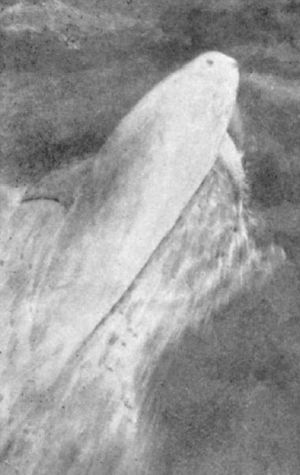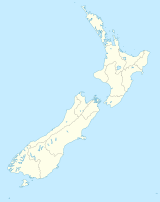Pelorus Jack facts for kids

Pelorus Jack in 1909
|
|
| Species | Risso's dolphin |
|---|---|
| Years active | 1888–1912 |
| Known for | Escorting ships near French Pass |
| Appearance | White colour with grey lines or shadings; round, white head |
Pelorus Jack was a famous Risso's dolphin who lived from about 1888 to April 1912. He became well-known for guiding ships through a tricky part of Cook Strait in New Zealand. For 24 years, he would meet and escort ships through the waters near French Pass. This area is known for being dangerous for ships.
It's not fully clear how Pelorus Jack got his name. Some say he was named after a navigation tool called a pelorus. Others believe his name came from Pelorus Sound, a nearby body of water. This is where he often met ships to guide them.
Sadly, Pelorus Jack was once shot at from a ship. Because of this, a special law was passed in New Zealand in 1904 to protect him.
Contents
What Did Pelorus Jack Look Like?
Pelorus Jack was a large dolphin, about 4 meters (13 feet) long. He had a white body with grey lines or shaded areas. His head was round and also white.
Even though his gender was never known, photos helped identify him as a Risso's dolphin. This type of dolphin is quite rare in New Zealand waters. Only a few Risso's dolphins have been seen there.
The Story of Pelorus Jack
Pelorus Jack would guide ships by swimming right alongside them for about 20 minutes at a time. If a ship's crew didn't see him right away, they would often wait for him to appear.
Even though he was called "Pelorus Jack," he didn't live in Pelorus Sound. Instead, he often guided ships through the risky passages of French Pass. However, some people who knew his habits said he never actually went through French Pass itself. They claimed he stayed near the Chetwode Islands.
How Pelorus Jack Started Guiding Ships
Pelorus Jack was first seen around 1888. He appeared in front of a ship called the Brindle as it neared French Pass. This channel is located between D'Urville Island and the South Island. When the crew saw the dolphin, some wanted to harm him. But the captain's wife convinced them not to. To their surprise, the dolphin then guided the ship safely through the narrow channel.
For many years after that, he safely guided almost every ship that passed by. The area has many rocks and strong currents, making it dangerous for ships. But no shipwrerecks happened when Jack was there to help.
Many sailors and travelers saw Pelorus Jack. He was often written about in local newspapers. His image also appeared on postcards.
Pelorus Jack's Disappearance
Pelorus Jack was last seen in April 1912. There were many rumors about what happened to him. Some people worried that foreign whalers might have caught him. However, studies suggest that Pelorus Jack was an old dolphin. His white head and pale body were signs of his age. It's most likely that he died naturally.
Since 1989, Pelorus Jack has been a symbol for the Interislander. This is a ferry service that crosses the Cook Strait. His image is even painted on the ships in their fleet.
The Shooting Incident
In 1904, someone on board the ship SS Penguin tried to shoot Pelorus Jack with a rifle. Even after this attempt on his life, Pelorus Jack continued to help other ships. However, an old story says that he never helped the Penguin again. The Penguin later sank in Cook Strait in 1909.
How Pelorus Jack Was Protected
After the shooting incident, a law was suggested to protect Pelorus Jack. He officially became protected by law on September 26, 1904. This protection lasted until he disappeared in 1912. Many believe he was the first individual sea creature ever protected by law in any country.
See also
 In Spanish: Pelorus Jack para niños
In Spanish: Pelorus Jack para niños



